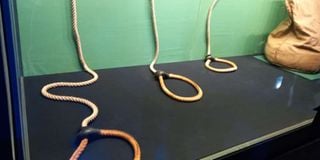Why 1,000 hangman’s nooses are being placed at new Uhuru Gardens museum

The gallery will contain 1,000 nooses hanging from the ceiling to symbolise their torturous death, one of the greatest sacrifices made by Kenya’s forefathers during the struggle for independence.
You can now find information regarding one of Kenya’s deadliest massacres during the state of emergency between 1952 and 1960 at the newly commissioned Uhuru Gardens museum.
Rebellion against British colonialists had reached its peak, with Mau Mau fighters staging attacks against government soldiers as their supporters took oaths to protect them and support their cause.
In October 1952, the British declared a state of emergency and began moving army reinforcements into the country to counter the insurgency that lasted until 1960.
It is during this period that thousands of suspected members of the Mau Mau movement were detained without trial at British concentration camps in Lang’ata, beaten, denied food and tortured as others were killed by hanging by the administration.
Kenya Prisons records released to the Uhuru Gardens National Museum and Monument show that about 1,000 were killed by hanging.
Their deaths will now be immortalised in a unique section in the museum called the “Rope Gallery”.

A bible owned by the late President Daniel Arap Moi place at Uhuru Gardens National Monument and Museum.
The gallery will contain 1,000 nooses hanging from the ceiling to symbolise their torturous death, one of the greatest sacrifices made by Kenya’s forefathers during the struggle for independence.
The gallery will also display the instruments of torture that the fighters were subjected to before they were hanged and their bodies disposed of, as well as testimonies from people whose relatives were killed by British soldiers.
Already on display are a set of items used on prisoners before they were hanged, including a weighing scale, a shaker to quell the noise of the dying prisoner, several nooses and a coffin to symbolise death.
President Uhuru Kenyatta thanked the Kenya Prisons boss, retired Brigadier John Warioba, for helping trawl prison archives to provide the list of heroes whose key role reminds future generations of the painful struggle for independence.
Maimed for life
He also thanked the Kenya Defence Forces for taking the lead role in refurbishing the facility that holds significant value for the country’s history.

Some of the artfacts at the Uhuru Gardens National Monument and Museum.
He said it is not just the land where many Kenyans were tortured and maimed for life as others died but also the grounds where the British flag (Union Jack) was brought down and Kenya’s flag hoisted and the national anthem played for the first time on December 12, 1963.
After years of what looked like neglect, leading to the attempted grabbing of parts of the land, the property has now been secured and rebuilt into a modern haven of monuments and museums in a record 22 months.
From the skies, the new-look Uhuru Gardens takes the shape of the court of arms, symbolising unity and defence of freedom.
Inside, it bears a series of galleries that tell the story of Kenya’s struggles, current state and future aspirations.
Sixteen of an expected 33 galleries are complete and ready for viewing. They include the Rope Gallery and one called Birth of Kenya that demonstrates the country’s significant path to modernisation immortalised by the Lunatic Express steam engine.
A military gallery showcases some of Kenya’s past defence weapons, including choppers, vehicles and artillery that the KDF has relied upon to secure the country’s borders from external aggression through the decades.
Some 12,300 artefacts collected from different parts of the country have been placed in the galleries, including Kenya’s first Constitution, the pen that inscribed it and the national flag that was hoisted at the Uhuru Gardens on December 12, 1963.





